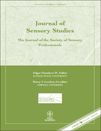EXTERNAL PREFERENCE MAPPING OF COMMERCIAL ANTIAGING CREAMS BASED ON CONSUMERS' RESPONSES TO A CHECK-ALL-THAT-APPLY QUESTION
Abstract
ABSTRACT
Due to the increasing demand for antiaging products, cosmetic companies need to count on reliable methodologies for new product development. In this context, the aim of the present work was to determine whether external preference mapping based on consumers' responses to a check-all-that-apply (CATA) question was applicable for studying consumers' preferences for commercial antiaging cosmetic creams. Six commercial antiaging creams were evaluated by a panel of 69 consumers, who were asked to indicate their overall liking and to answer a CATA question. Highly significant differences were found in the frequency in which consumers used 26 out of the 42 terms of the CATA question. The application of external mapping on the samples' configuration from the multiple factor analysis performed on CATA counts enabled a quick identification of regions of maximum liking within the sensory space defined by the evaluated samples and the drivers of liking responsible for consumers' preferences.
PRACTICAL APPLICATIONS
By using different groups of terms in the CATA question, relevant information about consumers' perception of different aspects of the samples was gathered. This information could be useful for product development and the definition of marketing and communication strategies. The application of external preference mapping on consumers' responses to a CATA question might be a reliable and interesting option when cosmetic companies face difficulties in using trained assessors' panels.




